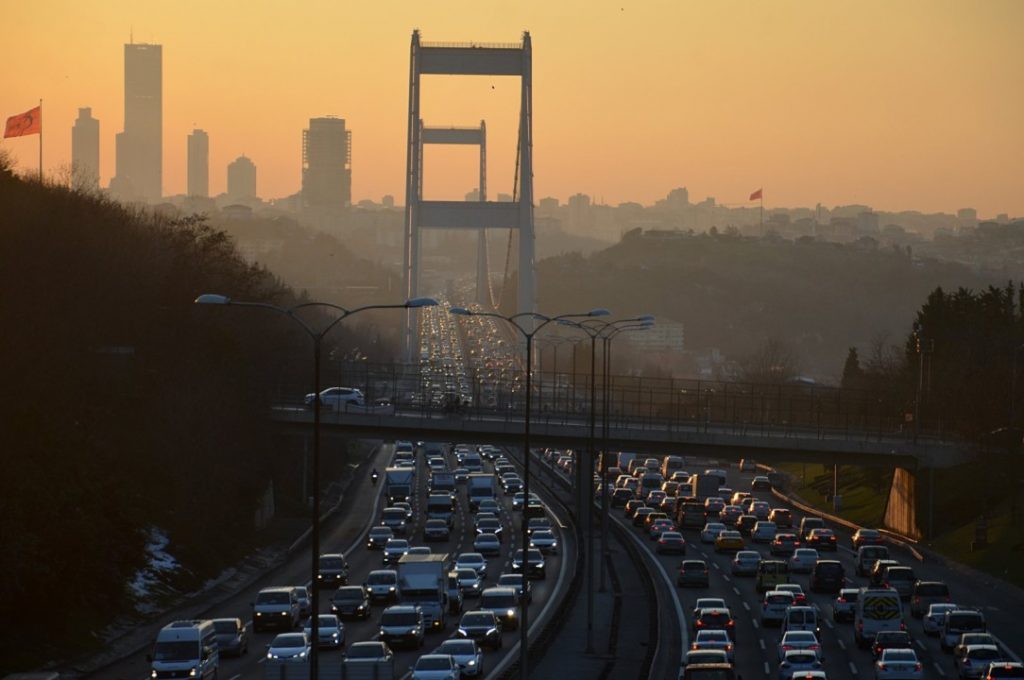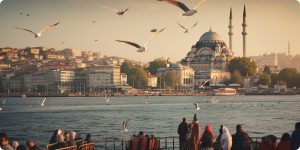

Istanbul, a city that bridges two continents, is known for its rich history, vibrant culture, and unfortunately, its notorious traffic congestion. The sprawling metropolis faces significant challenges in managing its traffic flow, impacting daily life and economic productivity. With a population exceeding 15 million and millions of tourists visiting each year, the pressure on Istanbul’s transport infrastructure is immense. Traffic jams not only cause frustration for residents and visitors but also lead to significant economic losses due to wasted time and fuel. This article explores practical strategies to combat traffic jams in Istanbul, offering a detailed look at various solutions and highlighting the role of our transfer service, GetTransfer, in alleviating this urban headache.
2. The Traffic Problem in Istanbul
Istanbul’s traffic congestion is a result of rapid urbanization, population growth, and an increase in the number of vehicles on the road. The city’s unique geography, with narrow streets and historic districts, exacerbates the problem. The Bosphorus Strait, dividing the European and Asian sides of the city, adds another layer of complexity to traffic management. During peak hours, major thoroughfares such as the E-5 and TEM highways become gridlocked, causing delays and frustration for commuters. Additionally, the city’s historical layout, designed long before the advent of modern vehicles, is ill-equipped to handle the current traffic volumes. This congestion not only affects daily commutes but also has broader implications for the city’s economy and environment. Addressing these challenges requires a multifaceted approach, integrating modern technology and innovative solutions to create a more efficient and sustainable urban transport system.
3. Key Strategies to Combat Traffic Jams
Public Transportation Enhancement
One of the most effective ways to reduce traffic congestion is by enhancing public transportation. Istanbul’s extensive metro, tram, and bus networks serve millions daily, but improvements are necessary to handle the growing demand. Expanding these networks, increasing frequency, and ensuring reliable service can encourage more people to use public transport instead of private cars. For example, extending metro lines to underserved areas and increasing the number of buses during peak hours can significantly alleviate pressure on the roads. Furthermore, integrating different modes of public transport to create a seamless and efficient transit system is crucial. The Istanbul Metropolitan Municipality has been investing in new metro lines and modernizing existing ones, aiming to create a comprehensive and user-friendly public transport network. Enhancing the comfort, safety, and accessibility of public transport can also attract more users, reducing the reliance on private vehicles and subsequently easing traffic congestion.
Road Infrastructure Improvement
Upgrading road infrastructure is crucial for easing traffic jams. This includes building new roads, widening existing ones, and creating more efficient intersections and roundabouts. In Istanbul, the construction of new tunnels and bridges, such as the Marmaray and Yavuz Sultan Selim Bridge, has already shown positive impacts on traffic flow. These projects have provided alternative routes for vehicles, reducing the burden on older, more congested roads. Additionally, the development of smart road systems that can adapt to changing traffic conditions in real-time can further improve traffic management. For instance, implementing dynamic lane usage, where lanes can change direction based on traffic flow, can optimize road capacity. Continuous maintenance and timely upgrades of existing roads are also essential to ensure smooth traffic flow and prevent bottlenecks. Moreover, investing in pedestrian infrastructure, such as overpasses and underpasses, can help separate foot traffic from vehicular traffic, reducing congestion and improving safety for all road users
Traffic Management Systems
Implementing advanced traffic management systems can significantly reduce congestion. Intelligent traffic lights that adapt to real-time traffic conditions, along with comprehensive monitoring and control centers, can optimize traffic flow and reduce waiting times. Istanbul’s Integrated Traffic Management System (ITMS) is a step in the right direction, utilizing cameras and sensors to manage traffic dynamically. By analyzing data from various sources, ITMS can predict traffic patterns and adjust signal timings accordingly, minimizing delays and improving overall traffic efficiency. Additionally, deploying traffic information systems that provide real-time updates to drivers about road conditions, accidents, and alternative routes can help distribute traffic more evenly across the road network. The use of mobile apps and navigation systems that offer real-time traffic information can also empower drivers to make informed decisions, avoiding congested areas and reducing overall traffic load. Furthermore, collaboration between public authorities and private technology companies can drive innovation in traffic management, leveraging the latest advancements in artificial intelligence and machine learning to create smarter, more responsive traffic systems.
Promotion of Non-Motorized Transport
Encouraging the use of bicycles and walking can also help decrease traffic congestion. Developing dedicated bike lanes, pedestrian-friendly zones, and public bike-sharing programs can make non-motorized transport more appealing. Istanbul’s recent initiatives, such as the establishment of bike lanes along popular routes, are commendable efforts. Creating safe and convenient infrastructure for cyclists and pedestrians can encourage more people to choose these modes of transport, reducing the number of vehicles on the road. Additionally, promoting active transportation has significant health and environmental benefits, contributing to a more sustainable and livable city. Initiatives such as car-free days, where certain streets are closed to vehicular traffic, can also raise awareness and encourage residents to explore alternative modes of transportation. Public awareness campaigns highlighting the benefits of walking and cycling, combined with incentives such as bike-sharing memberships or discounts on public transport for those who cycle, can further promote non-motorized transport. By fostering a culture of active transportation, Istanbul can reduce traffic congestion and improve the quality of life for its residents.
Implementation of Carpooling Services
Carpooling reduces the number of vehicles on the road by allowing multiple people to share a ride. This not only decreases traffic but also lowers emissions and fuel consumption. GetTransfer offers a reliable carpooling service, providing an efficient alternative to single-occupancy vehicle travel. By matching passengers with similar routes, GetTransfer maximizes the utilization of each vehicle, reducing the total number of trips and easing traffic congestion. Additionally, carpooling can foster a sense of community among commuters and provide cost savings for participants. Promoting carpooling through dedicated lanes, parking incentives, and public awareness campaigns can further encourage its adoption. Companies and organizations can also play a role by offering carpooling programs for their employees, reducing the number of cars on the road during peak hours. By integrating carpooling into the broader transportation strategy, Istanbul can create a more efficient and sustainable urban mobility system.
4. Case Studies and Examples
Marmaray Project
The Marmaray Project, a rail transportation project connecting the European and Asian sides of Istanbul, has significantly alleviated traffic congestion on the Bosphorus bridges. By providing a direct and fast alternative to road transport, it has reduced the number of cars and buses crossing the bridges daily. The project includes an underwater rail tunnel, the first of its kind in the region, offering a reliable and efficient mode of transport for thousands of commuters. Since its inauguration, the Marmaray has seen a steady increase in passenger numbers, demonstrating the demand for high-capacity, cross-continental transit options. The success of the Marmaray Project highlights the importance of investing in large-scale public transportation infrastructure to address urban traffic challenges. By continuing to expand and improve such projects, Istanbul can further reduce road congestion and enhance overall mobility in the city.
Yavuz Sultan Selim Bridge
The Yavuz Sultan Selim Bridge, the third bridge over the Bosphorus, has played a crucial role in diverting heavy vehicle traffic away from the city center. This bridge has not only eased congestion but also contributed to economic growth by improving logistics and transportation efficiency. Designed to accommodate both road and rail traffic, the Yavuz Sultan Selim Bridge is a key component of Istanbul’s transportation network, providing a critical link for freight and passenger transport. Its strategic location and state-of-the-art design have made it a vital infrastructure project, supporting the city’s ongoing development. The bridge’s impact on reducing traffic congestion in central Istanbul underscores the importance of creating alternative routes and bypasses to distribute traffic more evenly. Future projects inspired by the success of the Yavuz Sultan Selim Bridge can further enhance Istanbul’s transport infrastructure, mitigating congestion and supporting sustainable urban growth.
5. The Role of GetTransfer in Alleviating Traffic
GetTransfer offers a range of services that help mitigate traffic congestion in Istanbul. Our transfer services provide a convenient and reliable alternative to traditional taxis and public transport. By offering options such as carpooling and shared rides, we reduce the number of vehicles on the road, contributing to smoother traffic flow. GetTransfer’s advanced booking system ensures timely pickups and drops, minimizing unnecessary trips and wait times. Additionally, our diverse fleet of vehicles caters to different needs, from solo travelers to large groups, ensuring efficient and comfortable transport solutions.
Benefits of Using GetTransfer:
- Efficiency: Our advanced booking system ensures timely pickups and drops, reducing waiting times and unnecessary trips. With GetTransfer, travelers can pre-book their transfers, avoiding the hassle of finding transport at the last minute.
- Comfort: Travelers enjoy comfortable rides in well-maintained vehicles, avoiding the stress of driving in heavy traffic. Our professional drivers are experienced and familiar with the best routes, ensuring a smooth and pleasant journey.
- Eco-Friendly Options: With carpooling and shared rides, GetTransfer promotes eco-friendly travel, reducing carbon emissions. By consolidating multiple passengers into a single vehicle, we help reduce the overall environmental impact of transportation.
- Customizable Services: GetTransfer offers a variety of vehicle options, from standard cars to luxury vans, catering to different preferences and requirements. Our services can be tailored to meet specific needs, whether it’s an airport transfer, intercity travel, or a special event.





